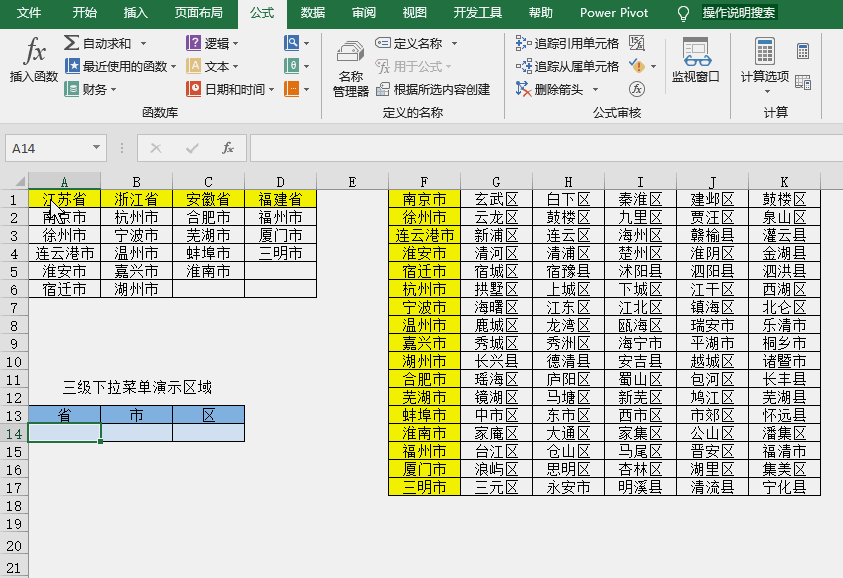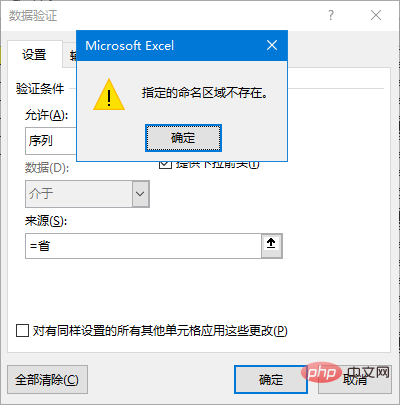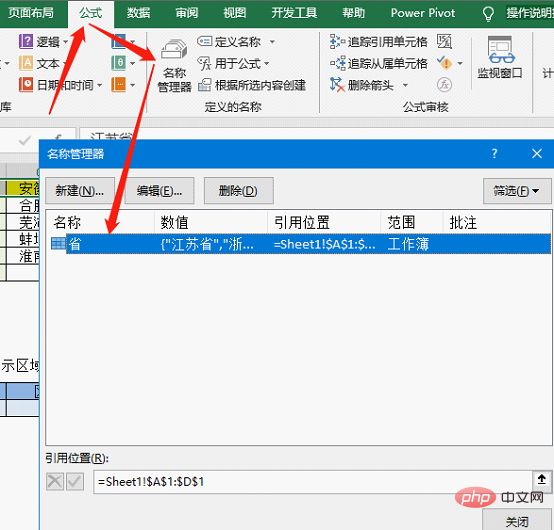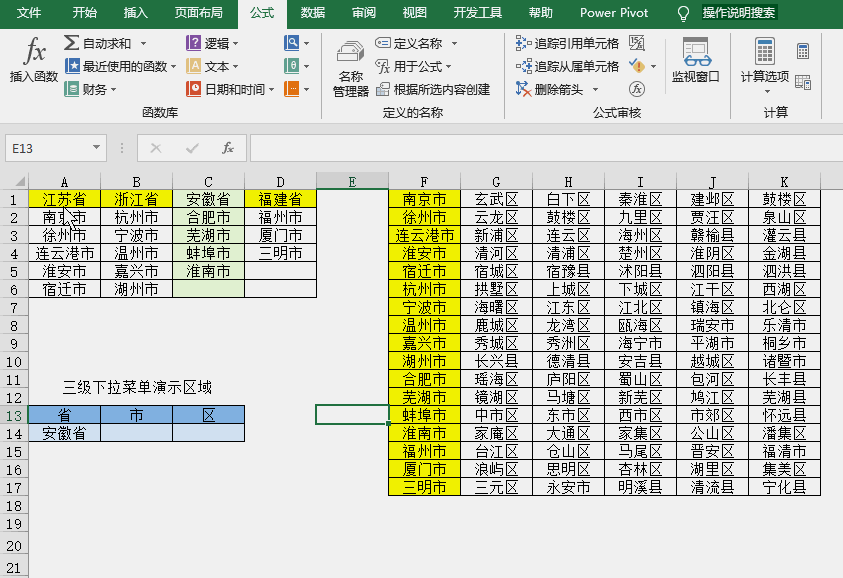 Topics
Topics
 excel
excel
 Practical Excel skills sharing: How to create two-level and three-level drop-down menus
Practical Excel skills sharing: How to create two-level and three-level drop-down menus
Practical Excel skills sharing: How to create two-level and three-level drop-down menus
When it comes to making drop-down menus, we all know that it can be achieved by directly using data verification in Excel, but second-level, third-level, or even higher-level drop-down menus may be a bit confusing. In fact, it is not difficult at all to use Excel to create a three-level drop-down menu. It is as simple as copying and pasting! Do not believe? Let’s read the article together and you will know!

Using data validation to create drop-down menus is familiar to most friends, but when it comes to second-level and third-level drop-down menus, you may not So familiar.
What are the second-level and third-level drop-down menus? For example, after selecting a province in a cell, only the city to which the province belongs can appear in the second cell option, and only the district to which the city belongs can appear in the third cell option. The effect is as shown in the figure.

It looks amazing. In fact, it is very easy to make such a multi-level drop-down menu. You only need to master two skills: defining names and data validation (data validity). ) can be achieved. Let’s take a look at the specific steps.
1. Create a first-level drop-down menu
Operation points:
[Quickly define name]Select the province where the name is located In the cell range "A1:D1", enter "Province" in the name box and press Enter to confirm;
[Set data verification] Select the cell where you want to set the first-level drop-down menu, open data verification, and set the sequence. Enter "=province" as the source, and a drop-down menu will be generated after confirmation. The operation steps are as shown in the animation.

Note: If "The specified named area does not exist" is prompted when setting data validation, it means that the definition of the name is incorrect.

# Check whether the name is successfully defined by clicking "Formula-Name Manager".

After the above operations, the setting of the first-level drop-down menu is completed.
2. Create a secondary drop-down menu
Operation points:
[Batch definition name] Select the province and affiliation The cell range where the city is located, that is, "A1:D6", in the "Formulas" tab "Defined Name", click "Create from selected content" to batch define names, and only check the "First row" when creating ";
After completion, you can check it through the name manager. At this time, there will be several more names corresponding to the provinces.
[Set data verification] Select the cell where you want to set the secondary drop-down menu, turn on the data verification, set the "sequence", enter "=INDIRECT(A14)" as the source, and after confirmation, the drop-down menu can be generated, and the operation The steps are shown in the animation.

In order to make it easier to set up the third-level menu later, we use a relative reference for A14 here.
Attention should be paid to this step: A14 in the formula needs to be modified according to the actual situation. The meaning of this formula is to use the cell data generated by the first-level menu as the basis for the effectiveness of the second-level menu.
After the above operations, the setting of the secondary drop-down menu is completed. You can verify the correctness of the options yourself.
About the INDIRECT function:
This function is a reference function. Simply speaking, it is quoted according to the specified address. In this example, A14 is a province name, and there is a set of corresponding cities in the name manager, as shown in the figure:

In this example, the function of the INDIRECT function is to get a set of names based on existing names. Corresponding data, if you need detailed tutorials on this function, you can leave a message to tell us.
3. Create a three-level drop-down menu
Operation points:
[Batch definition name ]Same as the previous step, select the cell range containing the city and district, that is, "F1:K17". Use the "Create from selected content" function to batch define names, and be careful to only check the "leftmost column" when creating;
[Copy Validity Settings] Copy the cell where the secondary drop-down menu is located, and when needed In the cell where the three-level drop-down menu is set, selectively paste "Verification" to complete the setting. The operation steps are as shown in the animation.

Because a relative reference is used in the validity formula of the cell where the secondary menu is located, just copy and paste cell B14 directly.
If you want to set the validity, the source should enter "=INDIRECT(B14)".
How about it, setting up the third-level menu is not that difficult.
Summary:
What I’m sharing today is just the most basic multi-level menu setting method. You need to pay attention to a few things.
1. When setting up a multi-level menu, the structure of the drop-down data source is very important. In this example, you can see the characteristics of the data source setting. As for whether the title should be in the first row or the leftmost column, it can be determined according to actual needs. Certainly.
2. The advantage of this setting method is that it is easy to master and easy to expand. According to the same method, it is not difficult to set up a fourth-level menu or even a fifth-level menu. But the disadvantages are also obvious. For example, when the number of options is different, blank options will appear in the drop-down box, and when the option content is increased, the name range needs to be modified, which is not very smart.

3. The core of setting up a multi-level menu is the usage of the INDIRECT function. If you want to make the drop-down menu more intelligent, do not contain blank items and automatically adjust when the content increases, You need to combine functions such as OFFSET, MATCH and COUNTA to achieve this. This requires considerable ability to use formula functions. If you are interested, please leave a message and tell the editor, and I will write another tutorial on this issue in the future.
Related learning recommendations: excel tutorial
The above is the detailed content of Practical Excel skills sharing: How to create two-level and three-level drop-down menus. For more information, please follow other related articles on the PHP Chinese website!

Hot AI Tools

Undresser.AI Undress
AI-powered app for creating realistic nude photos

AI Clothes Remover
Online AI tool for removing clothes from photos.

Undress AI Tool
Undress images for free

Clothoff.io
AI clothes remover

Video Face Swap
Swap faces in any video effortlessly with our completely free AI face swap tool!

Hot Article

Hot Tools

Notepad++7.3.1
Easy-to-use and free code editor

SublimeText3 Chinese version
Chinese version, very easy to use

Zend Studio 13.0.1
Powerful PHP integrated development environment

Dreamweaver CS6
Visual web development tools

SublimeText3 Mac version
God-level code editing software (SublimeText3)

Hot Topics
 1387
1387
 52
52
 What should I do if the frame line disappears when printing in Excel?
Mar 21, 2024 am 09:50 AM
What should I do if the frame line disappears when printing in Excel?
Mar 21, 2024 am 09:50 AM
If when opening a file that needs to be printed, we will find that the table frame line has disappeared for some reason in the print preview. When encountering such a situation, we must deal with it in time. If this also appears in your print file If you have questions like this, then join the editor to learn the following course: What should I do if the frame line disappears when printing a table in Excel? 1. Open a file that needs to be printed, as shown in the figure below. 2. Select all required content areas, as shown in the figure below. 3. Right-click the mouse and select the "Format Cells" option, as shown in the figure below. 4. Click the “Border” option at the top of the window, as shown in the figure below. 5. Select the thin solid line pattern in the line style on the left, as shown in the figure below. 6. Select "Outer Border"
 How to filter more than 3 keywords at the same time in excel
Mar 21, 2024 pm 03:16 PM
How to filter more than 3 keywords at the same time in excel
Mar 21, 2024 pm 03:16 PM
Excel is often used to process data in daily office work, and it is often necessary to use the "filter" function. When we choose to perform "filtering" in Excel, we can only filter up to two conditions for the same column. So, do you know how to filter more than 3 keywords at the same time in Excel? Next, let me demonstrate it to you. The first method is to gradually add the conditions to the filter. If you want to filter out three qualifying details at the same time, you first need to filter out one of them step by step. At the beginning, you can first filter out employees with the surname "Wang" based on the conditions. Then click [OK], and then check [Add current selection to filter] in the filter results. The steps are as follows. Similarly, perform filtering separately again
 How to change excel table compatibility mode to normal mode
Mar 20, 2024 pm 08:01 PM
How to change excel table compatibility mode to normal mode
Mar 20, 2024 pm 08:01 PM
In our daily work and study, we copy Excel files from others, open them to add content or re-edit them, and then save them. Sometimes a compatibility check dialog box will appear, which is very troublesome. I don’t know Excel software. , can it be changed to normal mode? So below, the editor will bring you detailed steps to solve this problem, let us learn together. Finally, be sure to remember to save it. 1. Open a worksheet and display an additional compatibility mode in the name of the worksheet, as shown in the figure. 2. In this worksheet, after modifying the content and saving it, the dialog box of the compatibility checker always pops up. It is very troublesome to see this page, as shown in the figure. 3. Click the Office button, click Save As, and then
 How to type subscript in excel
Mar 20, 2024 am 11:31 AM
How to type subscript in excel
Mar 20, 2024 am 11:31 AM
eWe often use Excel to make some data tables and the like. Sometimes when entering parameter values, we need to superscript or subscript a certain number. For example, mathematical formulas are often used. So how do you type the subscript in Excel? ?Let’s take a look at the detailed steps: 1. Superscript method: 1. First, enter a3 (3 is superscript) in Excel. 2. Select the number "3", right-click and select "Format Cells". 3. Click "Superscript" and then "OK". 4. Look, the effect is like this. 2. Subscript method: 1. Similar to the superscript setting method, enter "ln310" (3 is the subscript) in the cell, select the number "3", right-click and select "Format Cells". 2. Check "Subscript" and click "OK"
 How to set superscript in excel
Mar 20, 2024 pm 04:30 PM
How to set superscript in excel
Mar 20, 2024 pm 04:30 PM
When processing data, sometimes we encounter data that contains various symbols such as multiples, temperatures, etc. Do you know how to set superscripts in Excel? When we use Excel to process data, if we do not set superscripts, it will make it more troublesome to enter a lot of our data. Today, the editor will bring you the specific setting method of excel superscript. 1. First, let us open the Microsoft Office Excel document on the desktop and select the text that needs to be modified into superscript, as shown in the figure. 2. Then, right-click and select the "Format Cells" option in the menu that appears after clicking, as shown in the figure. 3. Next, in the “Format Cells” dialog box that pops up automatically
 How to use the iif function in excel
Mar 20, 2024 pm 06:10 PM
How to use the iif function in excel
Mar 20, 2024 pm 06:10 PM
Most users use Excel to process table data. In fact, Excel also has a VBA program. Apart from experts, not many users have used this function. The iif function is often used when writing in VBA. It is actually the same as if The functions of the functions are similar. Let me introduce to you the usage of the iif function. There are iif functions in SQL statements and VBA code in Excel. The iif function is similar to the IF function in the excel worksheet. It performs true and false value judgment and returns different results based on the logically calculated true and false values. IF function usage is (condition, yes, no). IF statement and IIF function in VBA. The former IF statement is a control statement that can execute different statements according to conditions. The latter
 Where to set excel reading mode
Mar 21, 2024 am 08:40 AM
Where to set excel reading mode
Mar 21, 2024 am 08:40 AM
In the study of software, we are accustomed to using excel, not only because it is convenient, but also because it can meet a variety of formats needed in actual work, and excel is very flexible to use, and there is a mode that is convenient for reading. Today I brought For everyone: where to set the excel reading mode. 1. Turn on the computer, then open the Excel application and find the target data. 2. There are two ways to set the reading mode in Excel. The first one: In Excel, there are a large number of convenient processing methods distributed in the Excel layout. In the lower right corner of Excel, there is a shortcut to set the reading mode. Find the pattern of the cross mark and click it to enter the reading mode. There is a small three-dimensional mark on the right side of the cross mark.
 How to insert excel icons into PPT slides
Mar 26, 2024 pm 05:40 PM
How to insert excel icons into PPT slides
Mar 26, 2024 pm 05:40 PM
1. Open the PPT and turn the page to the page where you need to insert the excel icon. Click the Insert tab. 2. Click [Object]. 3. The following dialog box will pop up. 4. Click [Create from file] and click [Browse]. 5. Select the excel table to be inserted. 6. Click OK and the following page will pop up. 7. Check [Show as icon]. 8. Click OK.



